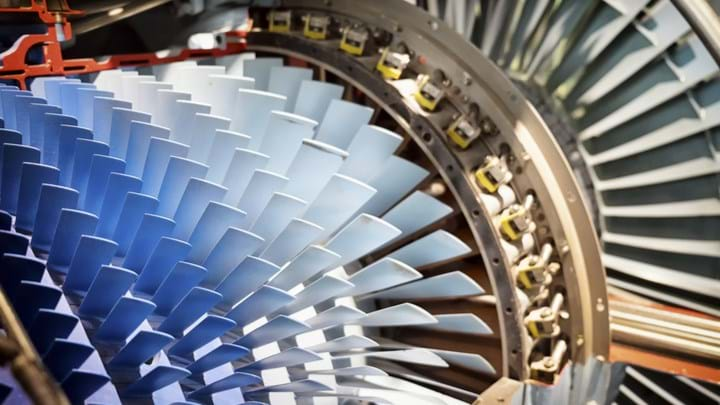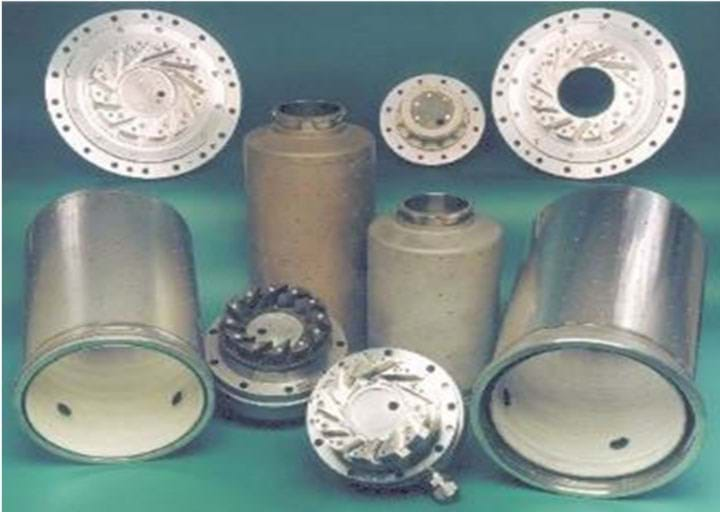Hydrogen as a Fuel for Gas Turbines

THERE are 39 Combined Cycle Gas Turbine power stations operational in the UK, with a nameplate capacity of almost 30 GW, as well as more than 350 industrial Combined Heat and Power (CHP) sites in the UK, producing around 5 GW of electricity.
There are many suppliers of Gas Turbines with offerings ranging from units with outputs of just a few MW to the latest utility-scale models of almost 600 MW in simple cycle.
Not all gas turbine manufacturers currently offer options for Natural Gas/hydrogen fuel mixtures but most of the major ones have developed combustion systems to handle off-spec gases to service markets such as steelworks off-gases (BFG, COG), IGCC applications, and bio- and waste-derived syngases. These off-spec gases include those with a high hydrogen content, and this article reviews the development status towards 100% hydrogen for one Gas Turbine manufacturer, Siemens.
Introduction
The Gas Turbine industry has evolved a great deal over the past century. The drivers for this in the power generation market have been improved efficiency, lower emissions, and increased output, whereas particularly for the aerospace market, reduced weight and smaller size have been the key criteria. These have often proved to be mutually exclusive, but so intense has been the competition between manufacturers that all the above have been achieved, often as a result of the introduction of new materials with improved properties.
The manufacture of larger Gas Turbines (>about 50 MW in simple cycle) particularly for power and CHP applications, has been dominated by a relatively small number of companies: General Electric (GE), Siemens, Mitsubishi Heavy Industries (MHI) and Ansaldo.
Medium-sized Gas Turbines (5–50 MW equivalent) are often developed for aerospace applications as the main market, though also find use in land-based applications including in, and in smaller-scale electricity production such as CHP or distributed power generation. There are other Gas Turbines serving the sub-5 MW market but these are not considered here.
Not all Gas Turbines will prove suitable for retrofit modifications to enable hydrogen combustion, in part or in whole. Redesign work with associated testing on older models, for instance, may not be justified compared to the cost of replacing the machine with a more up-to-date model for which the work has already been done.
Hydrogen combustion evolution
For many years, the heat from burning coal was used to boil water, superheat the steam and produce electricity by expanding it through a turbine/alternator. This is conventional power generation, the Rankine Cycle.
Another way to produce electricity was by burning Natural Gas in compressed air, expanding the hot combustion products through a power turbine and using the shaft power to drive both the compressor and a generator, known as Gas Turbine arrangement (Brayton Cycle).
Additional energy can be usefully extracted by using the hot exhaust gases to raise steam and produce further electricity conventionally in a turbine/alternator. This combination is described as a Combined Cycle Gas Turbine (CCGT).
When environmental damage to trees and land was linked to sulfur dioxide (SO₂) emissions from the coal flue gas of power stations, two technological routes were developed. One was to scrub the SO₂ from the flue gas, the other was to produce a synthetic gas (“Syngas”, a mixture of carbon monoxide and hydrogen) from the coal using a process called gasification. The Syngas is fed that into a Gas Turbine, to burn in a similar manner as Natural Gas. Chemical processes developed for the petrochemical industries, would wash the sulfur species from the syngas. This process was called Integrated Gasification Combined Cycle (IGCC). Because of the characteristics of the fuel gas were different, this necessitated developing different combustion arrangements for the Gas Turbines.
In the meantime, health and environmental concerns were raised over NOx production. Coal-fired power stations adopted low NOx burners and selective catalytic reduction. Gas Turbine manufacturers developed low NOx burners, using water- or steam-injection (so-called "wet" systems) for older models (in diffusion-type burners) and eventually "dry" variants for new machines, using staged or lean premix combustion techniques (so-called "Dry Low Emission", or DLE burners).
Because the DLE route avoids the use of water or steam, it is attractive because:
- water purity requirements are very high in order to avoid impurities depositing on the expansion turbine blades and reducing cooling, leading to hot spots;
- water is emitted as steam with the exhaust gases, which is a costly loss to the plant;
- water is recognised as a resource and industrial freshwater use needs to be minimised to conserve it;
- under some climactic conditions a visible plume can appear, which should be avoided if possible;
- water injection in particular, but steam as well, reduces the lifespan of turbine blades; and
- the water volumes required are considerable, and often cannot achieve the same levels of emission reduction as the "dry" techniques.

On the positive side there was some power enhancement as a consequence of increased mass flow through the expansion turbine, and as the water flashed off. For some fuels, wet combustors are currently the only choice, especially if very low levels of NOx emission are required.
Next, when global warming became linked to rising levels of atmospheric CO₂, emissions from the coal flue gas of power stations were identified as one of the main sources. Again, two technological routes were developed. One was post combustion capture, which involved scrubbing the CO₂ from the flue gas produced by conventional power stations.
The other is pre-combustion capture and involves processing the syngas from IGCC plants to produce just hydrogen, and to feed that into a Gas Turbine, to burn in the same way as Natural Gas. The CO₂ could be washed out together with the SO₂. Because of the very different characteristics of hydrogen as a fuel gas, compared to Natural Gas, even more combustion system changes would be required, along with changes to the auxiliary systems as well.
Again, two routes were followed for the Gas Turbines. One was to develop further the water- or steam-injected diffusion burners to use hydrogen, the other was to redesign the DLE burners to burn hydrogen. Both approaches are being developed by manufacturers, with DLE being the ultimate goal because they avoid all of the disadvantages described above.
Today, examples of each stage of development in the combustion process (see Figures 1 and 2) are still in use, even as the improved designs continue to become mainstream.

Siemens
Siemens offers a wide gas turbine portfolio from the KG2 Gas Turbine (2 MW in Simple Cycle) to the SGT5-9000HL (593MW as a Simple Cycle, more commonly found in its combined cycle configuration, 870MW in a 1x1 configuration). The smaller models are produced in Lincoln (UK), Finspång (Sweden) and Montreal (Canada), while the larger models are manufactured at its works in Berlin.
As well as Natural Gas, the company has considerable experience with both its small and large Gas Turbines operating on high hydrogen fuels, predominantly process off-gas, including large “Frame” machines operating on syngas in IGCC plants.
Siemens has experience in excess of 2m operating hours of burning fuels containing hydrogen derived from refineries, steelworks and coking works. While predominantly this experience has been gained on diffusion combustors, a recent order in South America will see a process off-gas with approximately 60%vol hydrogen used in a DLE combustor.
Large Gas Turbines
For Natural Gas/hydrogen mixtures, the larger machines have different capabilities depending on which type of combustor has been fitted. Siemens has tested its F-class machines with a hydrogen content ranging from 30% to 73% in fuel gas1. The test results showed the emissions and operation targets could be achieved.
Light industrial Gas Turbines
Considerable effort has been made in developing some of Siemens’ smaller industrial Gas Turbines to operate on Natural Gas/hydrogen mixes, both for diffusion and DLE combustors. Work in this area is continuing, particularly with the DLE burners, and increased hydrogen capabilities are under investigation.
For these smaller Gas Turbines fitted with DLE combustors, introducing up to 30 vol% of hydrogen into the Natural Gas system would apparently not present a technical problem for most models, but above that some modifications from the arrangement optimised for Natural Gas would be necessary. However, the DLE combustor design used on the turbines in the 25 MW–57 MW range (Simple Cycle, Natural Gas fuel) has been demonstrated to burn up to 60 vol% hydrogen (40% Natural Gas). Development work is in hand to deliver the low NOx performance at 100% hydrogen, expected to complete in the mid-2020s.
Aeroderivative Gas Turbines
The SGT-A35 (27.2–32.1MWe) aero-derivative with a DLE combustor can handle 15 vol% of hydrogen in the Natural Gas fuel, but with diffusion combustors, and water injection for NOx control, for both the SGT-A35 and SGT-A65 (53.1–66MW) up to 100 vol% hydrogen is possible. (Both Gas Turbine output figures are in Simple Cycle and dependent on configuration and model, with Natural Gas fuel at ISO conditions.)
Into the future
In common with other manufacturers, Siemens has set a target of being able to offer Gas Turbines capable of burning 100% hydrogen across the range, and is developing DLE combustors to service the expected demand. The challenge is to do this without compromising efficiency, startup times, and emissions of NOx. This is being achieved by developing combustor designs with an increasing proportion of hydrogen in Natural Gas. The DLE burner design used on the SGT-700 (33 MW) has demonstrated up to 40 vol% H₂ capability. Recent testing has shown that 50 vol% is possible on the SGT-800 (50 MW), which translates to 60 vol% on the SGT-600 (25 MW) as this operates at a lower temperature.
As the hydrogen economy unfolds over the next decade, there is a clear intention that Gas Turbines will be ready to meet the upcoming market without compromising today’s high performance expectations, in terms of emissions, response and efficiency.
Reference
1. Advanced Power Plant Materials, Design and Technology, edited by Dermot Roddy, Woodhead Publishing, 2010
This is the 15th article in a series discussing the challenges and opportunities of the hydrogen economy, developed in partnership with IChemE’s Clean Energy Special Interest Group. To read more from the series online, visit the series hub.
Recent Editions
Catch up on the latest news, views and jobs from The Chemical Engineer. Below are the four latest issues. View a wider selection of the archive from within the Magazine section of this site.




